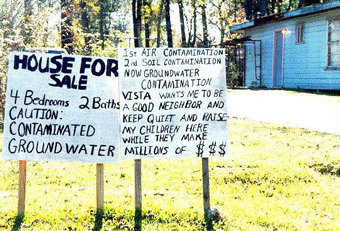One example of a fenceline community is Mossville, LA, also known as Cancer Alley. Mossville is predominantly African American community surrounded by 14 petrochemical plants.
The town has been ravaged by illness and it has been difficult for people to move since no one wants to move a town surrounded by factories.
"I got cancer. My dad had cancer. In fact, he died of cancer. It's a lot of people in this area who died of cancer," says Herman Singleton Jr., 51, who also lost two uncles and an aunt to cancer.Another example is the small town of Savoonga on St. Lawrence, AK, in the Bering Strait, near Russia. The town is near an abandoned U.S. military base.
"When the military vacated Northeast Cape in the early 1970s, they left at least thirty-four contaminated sites in a nine-square-mile area. Contamination includes at least 220,000 gallons of spilt fuel, as well as heavy metals, asbestos, solvents, and PCBs which are known to cause cancer."The town is still suffering the effects. In a village of 800, two babies were born without brains.
"As a result of these daily exposures to toxic chemicals, those of us who live in remote places like Alaska and the Arctic have some of the highest levels of toxic chemicals in our own bodies. On St. Lawrence Island we have very high levels of PCBs in our traditional foods and in our bodies, up to 10 times higher than average U.S. levels. Yupik women within the Yukon-Kuskokwim Delta area of Alaska have the highest levels of PBDEs -- toxic, flame-retardant chemicals -- in their blood. These chemicals have been linked to serious diseases such as cancer, diabetes, learning disabilities, birth defects and reproductive harm. People in my community are being harmed by all these diseases. Last year, we lost 19 people from cancer in a community of about 1,200."
"“We are tired of our communities being ‘sacrifice zones’ or ‘kill zones,’ ” Ms. Roberts added.
Ms. Roberts was referring to what the environmental injustice movement refers to as “the disproportionate” pollution burden borne by communities of color and poorer White communities, often located near freeways, power plants, toxic waste sites, oil refineries, rail yards, chemical plants and other major sources of pollution."




No comments:
Post a Comment